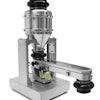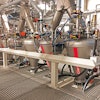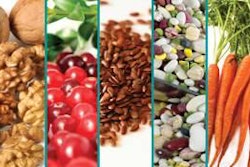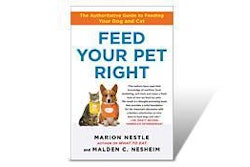[Read Dr. Ryan’s article on current research and knowledge on companion animal cancer and nutrition.]
Metabolomics is the identification and characterization of metabolic products in tissues and body fluids and can also be applied to the study of small molecules found in food. This mass spectrometry based approach has demonstrated robust and highly sensitive capabilities of examining thousands of small molecules and peptides that result from functional changes in the genome and transcriptome (Mensack et al., 2010; Heuberger et al., 2010).
Metabolomics may be useful to not only identify biomarkers for companion animal cancer detection and/or risk but also provides an immense opportunity to advance our knowledge of the metabolic changes that occur following pets’ dietary intake of bioactive food components. The utility of a metabolic signature modifiable by diet is that it can be integrated with recent advances in nutrigenomics and intestinal microbiome studies (Middelbos et al., 2010).
Dietary chemoprevention involves the use of chemicals, vitamins or other substances in the diet or to prevent or decrease the incidence of cancer. Chemopreventive agents have been broadly defined on the basis of their mechanisms of action and can be grouped into two general classes: blocking agents and suppressing agents.
Blocking agents—such as flavonoids, oltipraz, indoles, isothiocyanates—prevent carcinogenic compounds from reaching or reacting with critical target sites by preventing the metabolic activation of carcinogens or tumor promoters by enhancing detoxification systems and trapping reactive carcinogens. Suppressing agents—such as vitamin D and related compounds, nonsteroidal anti-inflammatory drugs, vitamin A and retinoids, DFMO, monoterpenes, calcium—prevent the evolution of the neoplastic process in cells that would otherwise become malignant.
We postulate there is a combination of nutritional imbalances that may occur during the lifetime of dogs or cats that ensue to favor the growth and progression of cancer cells. To our knowledge, no long-term dietary chemoprevention studies have been conducted in companion animals using evidence based trial designs. Given the difficulties associated with conducting companion animal studies on dietary supplements and cancer, the petfood industry should be cautious of single-nutrient health claims in veterinary oncology. One obvious reason is that nutrients do not function in isolation; rather, they function in vast, complex networks (e.g., antioxidant feedback and methylation pathways).
Another promising area of research related to diet and nutrition of companion animals with naturally occurring cancer is to study nutritional needs during the course of cancer treatment, including surgery, radiation, chemotherapy and palliative care (Ogilvie et al., 2000). Determining the efficacy of certain dietary components during cancer treatment in companion animals adds another layer of complexity to the already complicated set of interactions but may yield important information on health outcomes in a shorter time frame. Balancing host energetics, through adequate nutrition and physical activity, is considered a practical means to improve the daily quality of life of companion animals and may also translate to those animals with cancer or at high risk for developing cancer.
1. Steele, V.E., and R.A. Lubet. The use of animal models for cancer chemoprevention drug development. Semin Oncol 37:327-338.
2. Gullett, N.P., A.R. Ruhul Amin, S. Bayraktar, J.M. Pezzuto, D.M. Shin, F.R. Khuri, B.B. Aggarwal, Y.J. Surh, and O. Kucuk. Cancer prevention with natural compounds. Semin Oncol 37:258-281.
3. Kim, Y.S., and J.A. Milner. Bioactive food components and cancer-specific metabonomic profiles. J Biomed Biotechnol 2011:721213.
4. Lawler, D.F., B.T. Larson, J.M. Ballam, G.K. Smith, D.N. Biery, R.H. Evans, E.H. Greeley, M. Segre, H.D. Stowe, and R.D. Kealy. 2008. Diet restriction and ageing in the dog: major observations over two decades. Br J Nutr 99:793-805.
5. Brawer, R., N. Brisbon, and J. Plumb. 2009. Obesity and cancer. Prim Care 36:509-531.
6. German, A.J., V.H. Ryan, A.C. German, I.S. Wood, and P. Trayhurn. 2010. Obesity, its associated disorders and the role of inflammatory adipokines in companion animals. Veterinary Journal 185:4-9.
7. Basen-Engquist, K., and M. Chang. Obesity and cancer risk: recent review and evidence. Curr Oncol Rep 13:71-76.
8. Mensack, M.M., V.K. Fitzgerald, E.P. Ryan, M.R. Lewis, H.J. Thompson, and M.A. Brick. 2010. Evaluation of diversity among common beans (Phaseolus vulgaris L.) from two centers of domestication using 'omics' technologies. BMC Genomics 11:686.
9. Heuberger, A.L., M.R. Lewis, M.H. Chen, M.A. Brick, J.E. Leach, and E.P. Ryan. Metabolomic and functional genomic analyses reveal varietal differences in bioactive compounds of cooked rice. PLoS One 5:e12915.
10. Middelbos, I.S., B.M. Vester Boler, A. Qu, B.A. White, K.S. Swanson, and G.C. Fahey, Jr. Phylogenetic characterization of fecal microbial communities of dogs fed diets with or without supplemental dietary fiber using 454 pyrosequencing. PLoS One 5:e9768.
11. Ogilvie, G.K., M.J. Fettman, C. H. Mallinckrodt, J.A. Walton, R.A. Hansen, D.J. Davenport, K.L. Gross, K.L. Richardson, Q. Rogers, and M.S. Hand. 2000. Effect of fish oil, arginine, and doxorubicin chemotherapy on remission and survival time for dogs with lymphoma: a double-blind, randomized placebo-controlled study. Cancer 88:1916-1928.
















